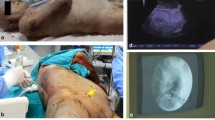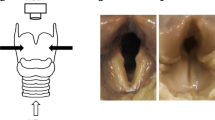Abstract
The traditional apprenticeship approach to surgical skill education for young surgeons has drastically changed to more systematic surgical training using cadavers. Cadavers fixed with formalin are not suitable for surgical training because of their associated health hazards and overhardening. Recently, we established a formalin-free soft preservation method for human cadavers using N-vinyl-2-pyrrolidone. Since 2012, 61 cadavers have been embalmed with pyrrolidone in our institution. Tissues of pyrrolidone-embalmed cadavers are soft and pliable, and their bodies can be preserved for as long as 37 months without any signs of corruption. In this review, we introduce our recent attempts to apply pyrrolidone-embalmed cadavers in surgical and medical procedure training, including endotracheal intubation, motion physiology of the vocal folds, laparoscopic surgery, endoscopic skull base surgery, and development of novel medical devices. Future research perspectives on pyrrolidone embalming are discussed.


Reproduced from Haizuka et al. (2018) with permission from the publisher


Reproduced from Nagase et al. (2020) with permission from the publisher

Reproduced from Maruyama et al. (2019) with permission from the publisher
Similar content being viewed by others
Change history
19 May 2022
The original online version of this article was revised due to correct the order of the supplementary videos.
References
(No authors listed) (2012) Japan surgical society and Japanese association of anatomists: guideline for cadaver dissection in education and research of clinical medicine. Kaibogaku Zasshi 87:21-23
Balta JY, Cronin M, Cryan JF, O’Mahony SM (2015) Human preservation techniques in anatomy: a 21st century medical education perspective. Clin Anat 28:725–734
Barton DP, Davies DC, Mahadevan V et al (2009) Dissection of soft-preserved cadavers in the training of gynaecological oncologists: report of the first UK workshop. Gynecol Oncol 113:352–356
Benkhadra M, Faust A, Ladoire S et al (2009) Comparison of fresh and Thiel’s embalmed cadavers according to the suitability for ultrasound-guided regional anesthesia of the cervical region. Surg Radiol Anat 31:531–535
Bilge O, Celik S (2017) Cadaver embalming fluid for surgical training courses: modified Larssen solution. Surg Radiol Anat 39:1263–1272
Blum F (1893) Der formaldehyde als hartungsmittle. Microsc Acta 10:314–315
Bonjer HJ, Deijen CL, Abis GA et al (2015) A randomized trial of laparoscopic versus open surgery for rectal cancer. N Engl J Med 372:1324–1332
Brenner E (2014) Human body preservation - old and new techniques. J Anat 224:316–344
Coleman R, Kogan I (1998) An improved low-formaldehyde embalming fluid to preserve cadavers for anatomy teaching. J Anat 192(Pt 3):443–446
Dallan I, Castelnuovo P, Seccia V et al (2012) Combined transnasal transcervical robotic dissection of posterior skull base: feasibility in a cadaveric model. Rhinology 50:165–170
Fujikura Y, Kitamura H, Tachikawa S, Ina K (2009) The development of the formaldehyde substitution liquid for fixing and preserving the organ. Kaibogaku Zasshi 84(Supple):255
Goldmann K, Ferson DZ (2005) Education and training in airway management. Best Pract Res Clin Anaesthesiol 19:717–732
Goyri-O’Neill J, Pais D, Freire de Andrade F et al (2013) Improvement of the embalming perfusion method: the innovation and the results by light and scanning electron microscopy. Acta Med Port 26:188–194
Guo S, Schwab A, McLeod G et al (2012) Echogenic regional anaesthesia needles: a comparison study in Thiel cadavers. Ultrasound Med Biol 38:702–707
Haaf F, Sanner A, Straub F (1985) Polymers of N-vinylpyrrolidone: synthesis, characterization and uses. Polym J 17:143–152
Haizuka Y, Nagase M, Takashino S, Kobayashi Y, Fujikura Y, Matsumura G (2018) A new substitute for formalin: application to embalming cadavers. Clin Anat 31:90–98
Hammer N, Löffler S, Bechmann I, Steinke H, Hädrich C, Feja C (2015) Comparison of modified Thiel embalming and ethanol-glycerin fixation in an anatomy environment: potentials and limitations of two complementary techniques. Anat Sci Educ 8:74–85
Hammer N, Löffler S, Feja C et al (2012) Ethanol-glycerin fixation with thymol conservation: a potential alternative to formaldehyde and phenol embalming. Anat Sci Educ 5:225–233
Hayashi S, Homma H, Naito M et al (2014) Saturated salt solution method: a useful cadaver embalming for surgical skills training. Medicine (Baltimore) 93:196
Hayashi S, Naito M, Kawata S et al (2016) History and future of human cadaver preservation for surgical training: from formalin to saturated salt solution method. Anat Sci Int 91:1–7
Hocking G, Mitchell CH (2012) Optimizing the safety and practice of ultrasound-guided regional anesthesia: the role of echogenic technology. Curr Opin Anaesthesiol 25:603–609
IARC (International Agency for Research on Cancer) (2006) International agency for research on cancer monographs on the evaluation of the carcinogenic risk of chemicals to humans. No. 88: formaldehyde, 2-butoxyethanol and 1-tert butoxy-2-propanol. World Health Organization, Geneva
Ishikawa CC, Pinheiro TG, Hachiya A, Montagnoli AN, Tsuji DH (2017) Impact of cricothyroid muscle contraction on vocal fold vibration: experimental study with high-speed videoendoscopy. J Voice 31:300–306
Janczyk P, Weigner J, Luebke-Becker A, Kaessmeyer S, Plendl J (2011) Nitrite pickling salt as an alternative to formaldehyde for embalming in veterinary anatomy—a study based on histo- and microbiological analyses. Ann Anat 193:71–75
Kassam AB, Gardner P, Snyderman C, Mintz A, Carrau R (2005) Expanded endonasal approach: fully endoscopic, completely transnasal approach to the middle third of the clivus, petrous bone, middle cranial fossa, and infratemporal fossa. Neurosurg Focus 19:E6
Mühe E (1992) Long-term follow-up after laparoscopic cholecystectomy. Endoscopy 24:754–758
Macchi V, Munari PF, Brizzi E, Parenti A, De Caro R (2003) Workshop in clinical anatomy for residents in gynecology and obstetrics. Clin Anat 16:440–447
Maruyama K, Yokoi H, Nagase M et al (2019) Usefulness of N-vinyl-2-pyrrolidone embalming for endoscopic transnasal skull base approach in cadaver dissection. Neurol Med Chir (Tokyo) 59:379–383
Messmer C, Kellogg RT, Zhang Y et al (2010) A technique to perfuse cadavers that extends the useful life of fresh tissues: the Duke experience. Anat Sci Educ 3:191–194
Miyajima E, Tsunoda M, Sugiura Y et al (2015) The diagnosis of sick house syndrome: the contribution of diagnostic criteria and determination of chemicals in an indoor environment. Tokai J Exp Clin Med 40:69–75
Miyake S, Suenaga J, Miyazaki R et al (2020) Thiel’s embalming method with additional intra-cerebral ventricular formalin injection (TEIF) for cadaver training of head and brain surgery. Anat Sci Int 95:564–570
Miyamoto M, Nagase M, Watanabe I et al (2022) Excised human larynx in N-vinyl-2-pyrrolidone-embalmed cadavers can produce voiced sound by pliable vocal fold vibration. Anat Sci Int. https://doi.org/10.1007/s12565-021-00646-3
Nagase M, Kimoto Y, Sunami E, Matsumura G (2020) A new human cadaver model for laparoscopic training using N-vinyl-2-pyrrolidone: a feasibility study. Anat Sci Int 95:156–164
Nielsen GD, Larsen ST, Wolkoff P (2017) Re-evaluation of the WHO (2010) formaldehyde indoor air quality guideline for cancer risk assessment. Arch Toxicol 91:35–61
Pekedis M, Yoruk MD, Binboga E, Yildiz H, Bilge O, Celik S (2021) Characterization of the mechanical properties of human parietal bones preserved in modified larssen solution, formalin and as fresh frozen. Surg Radiol Anat 43:1933–1943
Sawhney C, Lalwani S, Ray BR, Sinha S, Kumar A (2017) Benefits and pitfalls of cadavers as learning tool for ultrasound-guided regional anesthesia. Anesth Essays Res 11:3–6
Shichinohe T, Kobayashi E (2022) Cadaver surgical training in Japan: its past, present, and ideal future perspectives. Surg Today 52:354–358
Szűcs Z, László CJ, Baksa G et al (2016) Suitability of a preserved human cadaver model for the simulation of facemask ventilation, direct laryngoscopy and tracheal intubation: a laboratory investigation. Br J Anaesth 116:417–422
Thiel W (1992) The preservation of the whole corpse with natural color. Ann Anat 174:185–195
Thiel W (2002) Supplement to the conservation of an entire cadaver according to W. Thiel. Ann Anat 184:267–269
Tolhurst DE, Hart J (1990) Cadaver preservation and dissection. Eur J Plast Surg 13:75–78
Tsuji DH, de Almeida ER, Sennes LU, Butugan O, Pinho SM (2003) Comparison between thyroplasty type I and arytenoid rotation: a study of vocal fold vibration using excised human larynges. J Voice 17:596–604
van Emden MW, Geurts JJ, Schober P, Schwarte LA (2018) Comparison of a novel cadaver model (fix for life) with the formalin-fixed cadaver and manikin model for suitability and realism in airway management training. Anesth Analg 127:914–919
Watanabe K, Tokumine J, Lefor AK et al (2021) Photoacoustic needle improves needle tip visibility during deep peripheral nerve block. Sci Rep 11:8432
Zwagerman NT, Zenonos G, Lieber S et al (2016) Endoscopic transnasal skull base surgery: pushing the boundaries. J Neurooncol 130:319–330
Acknowledgements
The authors sincerely thank those who donated their bodies to science so that anatomical research could be performed. Results from such research can potentially increase mankind’s overall knowledge that can then improve patient care. Therefore, these donors and their families deserve our highest gratitude. This work was supported by Grants-in-Aid for Scientific Research from the Japan Society for the Promotion of Science (18K06841).
Author information
Authors and Affiliations
Corresponding author
Ethics declarations
Conflict of interest
The authors declare that they have no conflict of interest.
Additional information
Publisher's Note
Springer Nature remains neutral with regard to jurisdictional claims in published maps and institutional affiliations.
Supplementary Information
Below is the link to the electronic supplementary material.〹
Supplementary file1 (MP4 146204 KB) Movie (mp4 format) of the mobilities of major joints in a pre-embalmed cadaver (94 years old, female, cause of death: senility)
Supplementary file2 (MP4 204275 KB) Movie (mp4 format) of the mobilities of major joints in the same cadaver as in Movie 1 after NVP embalming
Supplementary file3 (MP4 46746 KB) Movie (mp4 format) of the endotracheal intubation procedure using a Macintosh laryngoscope and endotracheal tube in the same NVP-embalmed cadaver as in Movie 1
Supplementary file4 (MP4 40106 KB) Movie (mp4 format) of the laparoscopic manipulation of the abdominal viscera with forceps (83 years old, male, cause of death: lung cancer)
Rights and permissions
About this article
Cite this article
Nagase, M., Nagase, T., Tokumine, J. et al. Formalin-free soft embalming of human cadavers using N-vinyl-2-pyrrolidone: perspectives for cadaver surgical training and medical device development. Anat Sci Int 97, 273–282 (2022). https://doi.org/10.1007/s12565-022-00664-9
Received:
Accepted:
Published:
Issue Date:
DOI: https://doi.org/10.1007/s12565-022-00664-9




